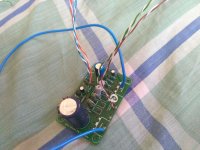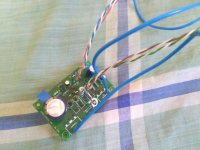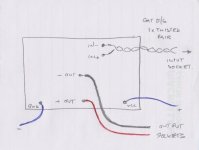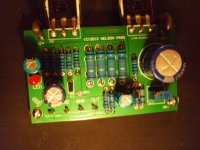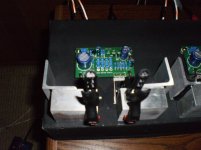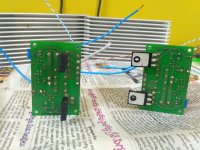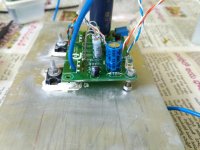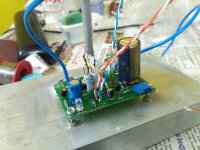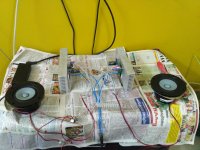Initially i have taken out the separate twisted pair strands from the cat-6 cable and thought to use them independently for each input and output points..
later thought may be if i could use the whole cat-6 cable instead of taking the individual strands out as it looked more protected and secure inside, when used cat-6 cable as a whole.. so as we had 4 pairs available i used used one cat-6 cable for each channel (mono block)..
So shall i take individual twisted pairs from the cat-6 cable outside and twist 4 strands together and out of those 4 strands use 2 for input positive and other 2 for input negative.
And similarly take another 4 strands and twist them together and out of those 4, use 2 strands for output positive and 2 for output negative (so here all will be individual wires without outer protection layers as in whole cat-6 cable)?
I have separated the cat-6 cable outer cover to get the individual strands separated as in photo .. so now one pair of strands for each input positive and negative and output positive and negative .. is it ok now ..
Attachments
Hi sarathssca,
I think this is what everyone is trying to advise you.
You only need a single twisted pair of CAT5/6 wires for each input. (Say white is - and coloured is +)
You need much thicker flexible multi strand wire for the outputs. Use the same gauge / thickness as the blue power wires in your picture. Red and black in my picture.
Keep the input and output wires apart as much as possible.
Hope that helps, Alan
I think this is what everyone is trying to advise you.
You only need a single twisted pair of CAT5/6 wires for each input. (Say white is - and coloured is +)
You need much thicker flexible multi strand wire for the outputs. Use the same gauge / thickness as the blue power wires in your picture. Red and black in my picture.
Keep the input and output wires apart as much as possible.
Hope that helps, Alan
Attachments
Last edited:
Question for Nelson Pass: ACA circuit boards
I have some ACA circuit boards, but I am not sure if they are earlier versions or copies authorized for discussion on this forum.
Can you review the attached photos and let me know if I am permitted to discuss these ACA boards and my project on this forum?
I have gone to the store but the "official" ACA boards are always sold out, so this is my last hope of presenting my project here.
dt 667
I have some ACA circuit boards, but I am not sure if they are earlier versions or copies authorized for discussion on this forum.
Can you review the attached photos and let me know if I am permitted to discuss these ACA boards and my project on this forum?
I have gone to the store but the "official" ACA boards are always sold out, so this is my last hope of presenting my project here.
dt 667
Attachments
I have some ACA circuit boards, but I am not sure if they are earlier versions or copies authorized for discussion on this forum.
Can you review the attached photos and let me know if I am permitted to discuss these ACA boards and my project on this forum?
I have gone to the store but the "official" ACA boards are always sold out, so this is my last hope of presenting my project here.
dt 667
These don't appear to be DIYAudio ACA boards, although the layout appears quite similar - I can't comment on whether or not you are permitted to discuss them, however.
-D
These don't appear to be DIYAudio ACA boards, although the layout appears quite similar - I can't comment on whether or not you are permitted to discuss them, however.
-D
It was suggested to me to ask Mr. Pass for permission to discuss my ACA circuit board and project since it is his forum.
I will wait for his reply and judgement on this matter before trying to post anything.
dt 667
DIY ACA project : measurement data & photos ...
With the approval of Nelson Pass, I can finally present my DIY ACA project.
The power supply features an AnTek AS-2218 PT with dual 18V secondaries.
FWBR into CLC filter with 44,000uF per channel.
The mosfet heatsinks are 2" x 2" 1" thick aluminum bar stock with some aluminum angle pieces for additional cooling. This keeps the heatsinks operating within 25C of ambient temperature measured after 1-2HRS.
THD +N @ 1W = 1.5%, 2W = 3%, 3W = 4.75% with 1KHz test signal.
Power Out before clipping was 3.5W.
Square waves looked perfect at 1KHz & 10KHz.
Subjectively, I enjoy this ACA project on Altec 2-way horn speakers.
The sound is very tube-like with its 2nd order dominant harmonic profile.
dt 667
With the approval of Nelson Pass, I can finally present my DIY ACA project.
The power supply features an AnTek AS-2218 PT with dual 18V secondaries.
FWBR into CLC filter with 44,000uF per channel.
The mosfet heatsinks are 2" x 2" 1" thick aluminum bar stock with some aluminum angle pieces for additional cooling. This keeps the heatsinks operating within 25C of ambient temperature measured after 1-2HRS.
THD +N @ 1W = 1.5%, 2W = 3%, 3W = 4.75% with 1KHz test signal.
Power Out before clipping was 3.5W.
Square waves looked perfect at 1KHz & 10KHz.
Subjectively, I enjoy this ACA project on Altec 2-way horn speakers.
The sound is very tube-like with its 2nd order dominant harmonic profile.
dt 667
Attachments
Finally assembled and got the amp sing .. 
- no thump sound at power on or off .. it's smoothly starting and stopping ..
- finally used 4 strands of cat-6 cable for each output positive and negative on one side.. my soldering job little ordinary only
- I couldn't get the bolt/connectors for mounting the board and MOSFETs on the heatsink as in other aca builds here .. I have used normal screw and nuts for this as in photos but faced difficulty in properly fitting the board and MOSFETs. Needed to put the screws from behind the heatsink and put the bolt on top as I couldn't put the bolt behind the heatsink .. also the holes for MOSFETs and PCB were not properly aligned as my heatsink has horizontal fins ..
- my heatsink r of size 190mm *95mm *33mm.. is it ok .. while running it's getting very very hot .. i haven't done any mod and these r running on 19v 90w power supply.. do I need to use bigger heatsink or small fan or another additional heatsink and fix it over these 2 heatsinks ..
- volume out of the alpair 7p speakers r coming little less only .. current volume is ok for near field .. now need to run these to break in the alpair 7p drivers
- no thump sound at power on or off .. it's smoothly starting and stopping ..
- finally used 4 strands of cat-6 cable for each output positive and negative on one side.. my soldering job little ordinary only
- I couldn't get the bolt/connectors for mounting the board and MOSFETs on the heatsink as in other aca builds here .. I have used normal screw and nuts for this as in photos but faced difficulty in properly fitting the board and MOSFETs. Needed to put the screws from behind the heatsink and put the bolt on top as I couldn't put the bolt behind the heatsink .. also the holes for MOSFETs and PCB were not properly aligned as my heatsink has horizontal fins ..
- my heatsink r of size 190mm *95mm *33mm.. is it ok .. while running it's getting very very hot .. i haven't done any mod and these r running on 19v 90w power supply.. do I need to use bigger heatsink or small fan or another additional heatsink and fix it over these 2 heatsinks ..
- volume out of the alpair 7p speakers r coming little less only .. current volume is ok for near field .. now need to run these to break in the alpair 7p drivers
Attachments
With the approval of Nelson Pass, I can finally present my DIY ACA project.
The power supply features an AnTek AS-2218 PT with dual 18V secondaries.
FWBR into CLC filter with 44,000uF per channel.
The mosfet heatsinks are 2" x 2" 1" thick aluminum bar stock with some aluminum angle pieces for additional cooling. This keeps the heatsinks operating within 25C of ambient temperature measured after 1-2HRS.
THD +N @ 1W = 1.5%, 2W = 3%, 3W = 4.75% with 1KHz test signal.
Power Out before clipping was 3.5W.
Square waves looked perfect at 1KHz & 10KHz.
Subjectively, I enjoy this ACA project on Altec 2-way horn speakers.
The sound is very tube-like with its 2nd order dominant harmonic profile.
dt 667
You have very high distortion and not much power before clipping. An original ACA should do better
Is bias correct adjusted?
Hum could be caused by floating input......bad Gnd at input etc.
First step is to check rail voltage and that DC voltages around the circuit is correct (of course the PCBs has to be correct assembled with no bad soldering etc.) then apply test generator (e.g. 1 kHz sine), oscilloscope…...trace signal from input to output. That would be my approach.....and be careful not making any shorts with the probe.
Hum could be caused by floating input......bad Gnd at input etc.
First step is to check rail voltage and that DC voltages around the circuit is correct (of course the PCBs has to be correct assembled with no bad soldering etc.) then apply test generator (e.g. 1 kHz sine), oscilloscope…...trace signal from input to output. That would be my approach.....and be careful not making any shorts with the probe.
ACA left channel sink warms up, but no sound. ACA right channel makes a circa 60 Hz hum with no sound. Please advise.
Thanks
pics
You have very high distortion and not much power before clipping. An original ACA should do better…..do you use "correct" FETs?
I used IRFP240 Mosfets as per BOM and biased them to 1/2 of V+.
I did notice something about an R15 resistor mod that is required to get better distortion performance when using earlier ACA boards, I'll have to study it a bit more. Maybe that would help with the bench test measurements.
dt 667
ACA left channel sink warms up, but no sound. ACA right channel makes a circa 60 Hz hum with no sound. Please advise.
Thanks
Sounds like two independent issues. Would isolate the two + connectors from the DC power jack and power each side one at a time.
Use alligator clips to get the power from the power supply plug, to the isolated amps.
You can even put the + lead straight into the center conductor of the supply plug and use an alligator clip to the outer conductor to connect to "ground".
See if they both come up when fed independently and if they do - suspect an issue with the power connector itself.
The AC hum: We were all recently reminded that input cables can go bad. So may swap the input with the other side before you get too carried away on that one.
- Home
- Amplifiers
- Pass Labs
- Amp Camp Amp - ACA
